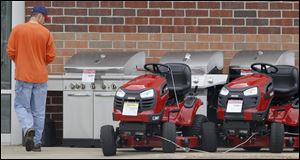
Economic recovery experiences a setback
Durable goods demand tumbles to 6-month low
5/26/2011
A customer looks over a display of grill sand lawn tractors at a Sears Hardware store in northeast Ohio's Geauga County.
WASHINGTON -- Businesses cut back on their orders for heavy machinery, computers, autos, and airplanes in April, reducing demand for long-lasting manufactured goods by the largest amount in six months.
Orders for durable goods fell 3.6 percent, and a key category that serves as a proxy for business investment was down 2.8 percent, the Commerce Department reported Wednesday.
The weakness was widespread across a number of industries as the impact of supply disruptions stemming from the Japanese earthquake in March rippled through U.S. manufacturing.
Demand for autos, auto parts, steel, computers, and electronic equipment all fell, and those declines were attributed in part to difficulty in getting critical component parts from Japan, where manufacturing has been disrupted by the March 11 earthquake and tsunami and nuclear plant disaster.
Many analysts viewed the setbacks as temporary, but said they could dampen manufacturing for several months, until U.S. companies find alternative supply sources.
Jennifer Lee, senior economist at BMO Capital Markets, said that the April durable goods report was just another sign that "the U.S. economy is encountering its fair share of speed bumps" at the moment.
Strong demand domestically and overseas has kept U.S. factories humming, making manufacturing one of the strongest sectors of the economy since the recession ended in June, 2009. The overseas demand has been supported by a weaker dollar, which makes U.S. products cheaper in foreign markets.
U.S. factories have added 167,000 jobs over the past six months, the best stretch of hiring gains in manufacturing since 1997.
The April decline left orders at $189.9 billion, still 22.5 percent below where orders were in December, 2007, the month the recession began.
However, the April level is 27.7 percent above the recession low hit in April, 2009.